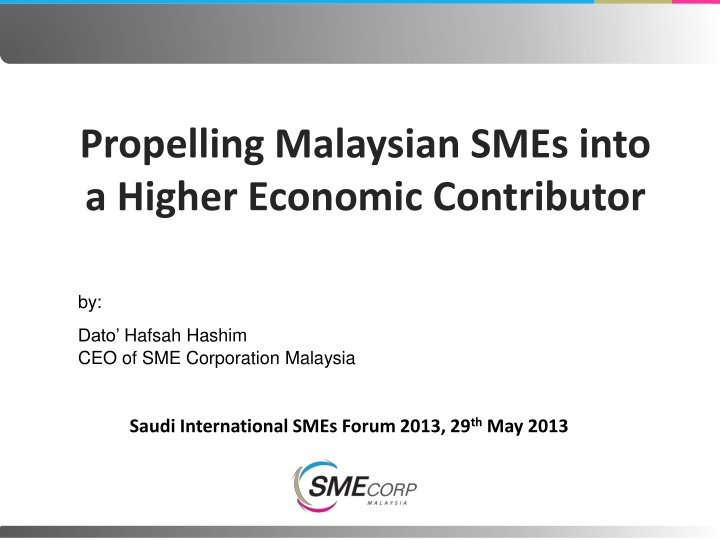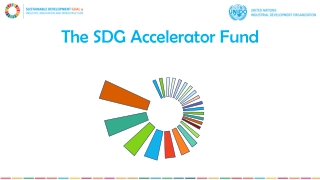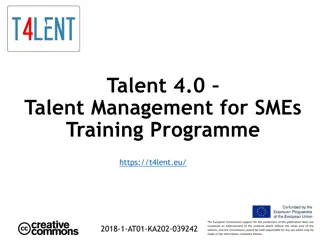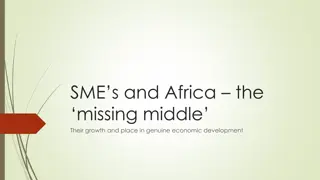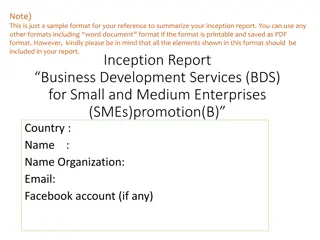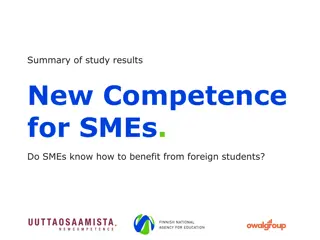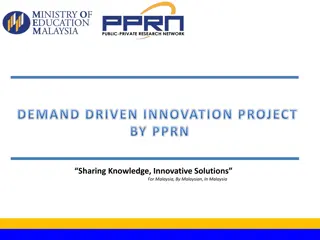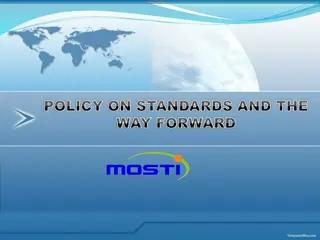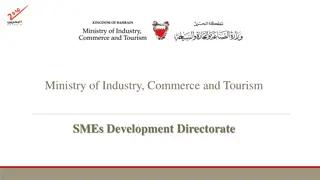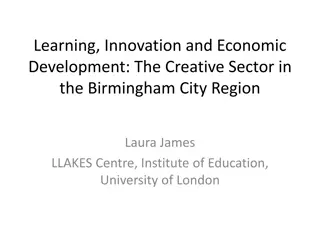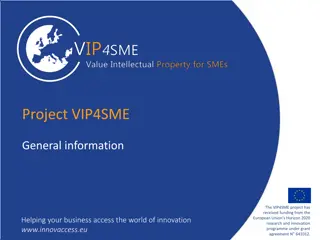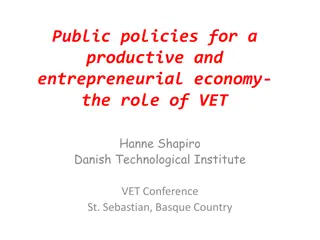Propelling Malaysian SMEs into a Higher Economic Contributor
SMEs play a pivotal role in Malaysia's economy, accounting for the bulk of businesses and serving as a key domestic growth source. With a focus on innovation and productivity, the SME Masterplan aims to further elevate their economic impact, ensuring sustained competitiveness and growth.
Download Presentation

Please find below an Image/Link to download the presentation.
The content on the website is provided AS IS for your information and personal use only. It may not be sold, licensed, or shared on other websites without obtaining consent from the author.If you encounter any issues during the download, it is possible that the publisher has removed the file from their server.
You are allowed to download the files provided on this website for personal or commercial use, subject to the condition that they are used lawfully. All files are the property of their respective owners.
The content on the website is provided AS IS for your information and personal use only. It may not be sold, licensed, or shared on other websites without obtaining consent from the author.
E N D
Presentation Transcript
Propelling Malaysian SMEs into a Higher Economic Contributor by: Dato Hafsah Hashim CEO of SME Corporation Malaysia Saudi International SMEs Forum 2013, 29thMay 2013
Definition of SMEs Annual sales turnover < RM25 million ( 5.42 million) OR Full time employees <150 Manufacturing, Manufacturing Related Services and Agro-based Industry Annual sales turnover < RM5 million ( 1.08 million) OR Full time employees < 50 Services, Primary Agriculture, Information and Communication Technology (ICT) 2
SMEs account for bulk of total businesses in Malaysia 97.3% 97.3% of total establishments (645,136) versus 548,267 on 2003 Mainly (77%) microenterprises Concentrated in services sector (90%) Services Distributive Trade and Repair of Motor Vehicles and Motorcycles (50%) Restaurants (25%) 90.0% Manufacturing Textiles & Wearing Apparel (26.5%) F&B Products (16%) 5.9% 3% 20% Construction Non residential buildings (21.5%) Civil Engineering (21.0%) 3.0% Total: 645,136 SMEs Agriculture Crops (70.4%) Livestock (13.4%) 1.0% Mining & Quarrying Stone Quarrying (83.6%) Mineral Mining (16.4%) 0.1% Micro 77% Small Medium 3 Source: Economic Census 2011
SMEs are the backbone of the economy Important domestic source of growth Total 97% Establishments Foundation & support in supply chain through forward & backward linkages 32% GDP Balanced growth 59% Employment Strengthen resilience of the nation's economy Provide support for growth of new & existing sectors 19% Exports Promote private sector-led growth 4 Source: Economic Census 2011
SME Value Added and Overall GDP Growth SME growth outperformed overall GDP growth during 2004 2011: NSDC was set up and SME development accorded national agenda Other supportive policies (improvement in government delivery, higher domestic demand and tourism, focus on farmers and small contractors) GDP & SME Growth 12% GDP & SME Growth (yoy change) % 10% SME: 5.5 -6% 8% 6% 4% GDP: 5-5.5% 2% 0% 2001 2002 2003 2004 2005 2006 2007 2008 2009 2010 2011e -2% Year -4% GDP Growth SME Growth Source: DOSM and SME Corp. Malaysia 5
Moving forward, SME development to be innovation-led and productivity-driven through the SME Masterplan Unless we introduce a game changer , we will be caught in a middle-income trap, and no longer as competitive on cost... the Government would adopt a differentiated approach to accelerate the growth of SMEs and to provide the impetus for growth led by the private sector. an innovation-led economy demands a new breed of SMEs that can help foster market and technology-driven innovation to create more high-skilled jobs in all economic sectors. Prime Minister of Malaysia / Chairman of National SME Development Council 6
SME Masterplan takes a new approach in SME development Innovation and productivity-led Public-private partnership Outcome-based Approach Approach Live plan 7
New SME Development Framework for innovation-led and productivity-driven growth Globally competitive SMEs across all sectors that enhance wealth creation and contribute to the social well-being Vision SME Development Framework Expand number of high growth and innovative firms Increase business formation Intensify formalisation Raise Goals productivity Innovation & Technology Adoption Human Capital Development Legal & Regulatory Environment Access to Financing Focus Areas Infrastructure Market Access Action Plan Institutional Support Reliable database Monitoring & Evaluation Effective Coordination Effective Business Services 8
Plan proposes 32 initiatives across all focus areas, of which 6 are High Impact Programmes 6 High Impact Programmes (HIPs) Measures across 4 Themes Resource pooling & shared services Create demand for SME products Reduce information asymmetry Building capacity & knowledge Integration of business registration & licensing to enhance ease of doing business Technology Commercialisation Platform (TCP) to encourage innovation SME Investment Programme (SIP) to provide early stage financing Going Export (GoEx) Programme to expedite internationalisation of SMEs Catalyst Programme to promote more homegrown champions Inclusive Innovation to empower the bottom 40% Measures for East Malaysia Improve connectivity & basic amenities Review restrictive laws & policies Ease market access Other Measures Completion of Integrated trade clearance and facilitation system (single window) Bankruptcy Law to give entrepreneurs a second chance Synchronise measures on productivity enhancement technologies with other relevant labour policies Result-based approach with monitoring & evaluation 9
Target is to increase contribution to GDP to slightly over 40% by 2020 GDP Growth CAGR (% change) 9 New SME growth path Economic Contribution in 2020: Quantum leap 8 (8.7%) 2010 2020 7 Business as usual growth (6.5%) GDP 32% 41% 6 5 59% 62% Employment 4 19% 25% Exports 3 2000 - 05 2006 - 10 2011 - 20 Projections by SME Corp. Malaysia 10
Public Private Collaboration Malaysia Incorporated initiated in 1983 to recognise importance of private sector in economic growth Concept: Nation is a corporate or business entity, jointly owned by both sectors and working together in pursuit of a common mission of nation Deregulation of cumbersome bureaucratic rules & regulations Improving delivery system Operating Mechanism Institutionalising consultative machinery Establishing smart partnership programmes in nation building efforts Pursuing privatisation 11
3 structural mechanisms established to promote intersectoral consultation and cooperation Establishment of consultative panels Structure Dialogue sessions at various levels in public sector Promotion Joint sponsorship of formal or informal activities Funding 12
Public-private sector collaboration scaled new heights with establishment of PEMUDAH in February 2007 The Special Taskforce to Facilitate Business or PEMUDAH: High-powered taskforce to address bureaucracy in business-government dealings PEMUDAH Ministries / Agencies Industry Associations Chamber of Commerce 13
Way Forward : SME development a shared responsibility... Government Facilitator Act as catalyst Private Sector Associations, chambers & NGOs to develop SMEs Large firms to mentor SMEs Participation in design & implementation of progs. 14
..with private sector assuming a greater role Strengthen industry associations Develop capacity for private professional services for SMEs Increase range of services provided by associations What needs to be done? Build bridges between public and private sectors through shared services (funds, space) Encourage establishment of private finance providers Enhance capacity of private training and advisory provider 15
Bling - Business Linkages OBJECTIVES To develop competitive and innovative SMEs good database Pre-evaluated companies Good match To widen the business opportunity of SMEs in supplying products and services to large companies and Multinational Companies (MNCs) It's efficient To encourage business networking between SMEs and MNCs & GLCs 16
SME COMPETITIVENESS RATING FOR ENHANCEMENT (SCORE) Example of Radar Diagram for 3-Star company A diagnostic tool to rate and enhance competitiveness of SMEs based on their performances and capabilities. Developed in August 2007. What is SCORE? Identify strengths and weaknesses for improvements; and Facilitate linkages. Function Business Performance Financial Capability Management Capability Production Capability Technical capability Quality System Innovation 7 Parameters Analysis: Weak in financial capability Assistance: Requires training in financial management & improvement in quality management 0 2 : Very basic business operation 3 5 : Competitive and export-ready companies Characteristics MDEC PSDC SME Bank TM MPC HDC NCIA MTIB PUNB CIDB MINDEF TPM Collaborators 17
1-INNOCERT Innovation Certification for Enterprise Rating and Transformation Programme I. Innovation Ability To identify and certify innovative SMEs and enterprises in Malaysia II. Mission Commercialization Ability To foster and support innovative SMEs and enterprises to be global innovative competitive players III. Objective Innovation Management IV. Innovation Outcome To date, 115 companies have been certified 18
NATIONAL MARK OF MALAYSIAN BRAND To enhance the visibility of Malaysian products and services in both local and international markets. Operations Management Management Commitment & Capability Quality & Standards of Products/Services ASSESSMENT CRITERIA Financial Capability Management Best Practices Brand Management & Marketing Social Responsibility To date, 59 companies have been certified 19
www.smeinfo.com.my www.smecorp.gov.my SME Annual Report 2011/12 SME Corp. Malaysia 1-300-30-6000 Physical KL Sentral
